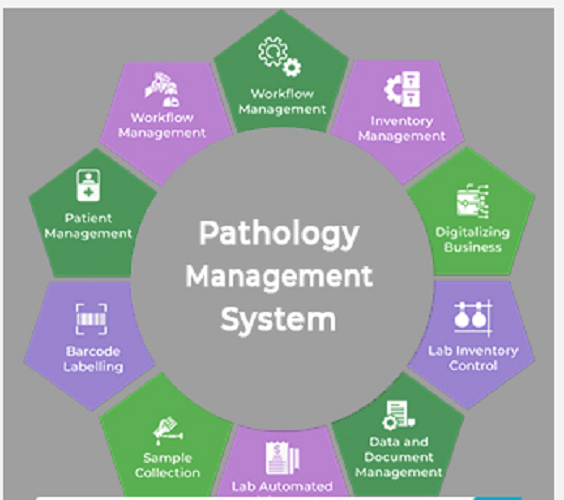
✅ Pathology Management Software
Pathology Management Software is a comprehensive digital solution designed to streamline every aspect of your pathology lab or diagnostic center. From managing patient records and scheduling tests to generating reports and handling billing, this all-in-one software ensures speed, accuracy, and efficiency. Ideal for clinics and laboratories across the UAE, it simplifies lab workflows, reduces manual errors, and enhances patient satisfaction through real-time access to results. Whether you’re a growing lab in Dubai or a healthcare provider in Ajman, this software helps you deliver reliable, professional diagnostic services with complete control and automation.
🔍 What It Does:
Manage Patient Information: Securely stores patient profiles, test history, and reports.
Test Scheduling & Tracking: Handles appointment booking, sample collection, and test processing.
Automated Report Generation: Generates pathology reports quickly with minimal manual input.
Billing & Invoicing: Manages payments, insurance claims, and financial records.
Lab Workflow Management: Coordinates lab technicians, test status, and quality checks.
Doctor & Patient Access: Allows doctors and patients to view reports digitally.
Pathology Management Software is a specialized digital solution designed to manage and streamline all the operations within a pathology laboratory or diagnostic centre. It automates tasks such as test bookings, sample tracking, report generation, billing, and patient records, improving accuracy, speed, and workflow efficiency.
Pathology management software : it is an innovative technological solution designed to streamline and enhance the workflow within pathology laboratories. The role of this software is increasingly critical in the healthcare industry, as it supports the intricate processes involved in managing pathology specimens, patient data, and diagnostic results. By optimizing these workflows, pathology management software not only improves the operational efficiency of laboratories but also significantly elevates the quality of patient care.
Fully Details About : Pathology Management Software
One of the primary purposes of pathology management software is to facilitate accurate documentation and tracking of pathology cases. This software allows for the comprehensive management of patient information, specimen details, and reporting processes, ensuring that all data is readily accessible to authorized healthcare professionals. This level of accessibility is essential for effective communication among pathologists, clinicians, and other stakeholders, fostering a collaborative environment that ultimately benefits patient outcomes.
Furthermore, pathology management software comes equipped with various features designed to simplify day-to-day laboratory operations. These features typically include specimen tracking, automated reporting, image management, and integration with electronic health records (EHRs). Such capabilities enable laboratories to reduce errors, enhance turnaround times for results, and provide detailed analytics that inform clinical decision-making. The software’s role extends beyond mere data management; it acts as a pivotal tool for advancing healthcare delivery through improved accuracy and efficiency in pathology.
As the healthcare sector continues to evolve, the importance of pathology management software cannot be overstated. It represents a significant step toward modernizing pathology services, ultimately leading to enhanced patient care and improved health outcomes. This introduction serves as a foundation for exploring the various applications and transformational benefits of pathology management software within the healthcare landscape.
Key Features of Pathology Management Software
Pathology management software plays a vital role in enhancing the efficiency and accuracy of laboratory operations. One of its most crucial features is comprehensive specimen tracking, which enables healthcare providers to monitor samples from the moment they arrive in the lab to their final analysis. This tracking system reduces the likelihood of specimen mix-ups or losses, ensuring that results correspond to the correct patients, thus improving patient safety.
Another significant aspect of pathology management software is its ability to integrate seamlessly with existing laboratory information systems (LIS). This integration is essential for streamlining workflows, allowing for the automatic transfer of data between platforms. By minimizing the need for manual data entry, this feature not only reduces the incidence of errors but also saves valuable time for lab personnel, allowing them to focus on more critical tasks.
Advanced reporting capabilities are also a notable feature of pathology management software. These tools enable healthcare providers to generate detailed and customizable reports quickly, providing insights into laboratory operations and test results. Such reports can be essential for regulatory compliance and for tracking quality assurance metrics. Moreover, the ability to analyse data trends over time aids in identifying areas for improvement within laboratory processes.
The user-friendly interfaces found in modern pathology management software further enhance its utility. These intuitive designs ensure that lab staff of varying technical backgrounds can navigate the system efficiently without extensive training. This accessibility contributes to smoother operations, higher staff satisfaction, and ultimately faster turnaround times for test results. Collectively, these key features work in harmony to reduce errors, optimize lab processes, and improve patient outcomes.
Benefits of Implementing Pathology Management Software
The advent of pathology management software has transformed the operational landscape of healthcare organizations, particularly within pathology departments. One significant benefit derived from its implementation is the increased efficiency of laboratory processes. By automating routine tasks such as specimen tracking and report generation, pathology management software minimizes manual errors and reduces turnaround time, ultimately leading to quicker diagnostic results for patients. In many cases, clinics have reported a reduction in workflow bottlenecks, allowing them to handle a higher volume of cases without compromising the quality of care.
Additionally, the adoption of this software can lead to substantial cost savings for healthcare providers. By streamlining various administrative functions, organizations can significantly reduce labour costs and operational expenses. For example, a hospital that integrates pathology management software can allocate fewer resources to data entry and report preparation, enabling staff to focus on higher-value tasks. This financial efficiency can be crucial, especially in an environment where hospitals are often under financial pressure to deliver quality care while managing costs.
Moreover, improved workflow coordination is another noteworthy benefit. Pathology management software fosters enhanced communication between pathologists, clinicians, and laboratory personnel, which is essential for effective patient care. By providing a centralized platform for sharing information, the software helps ensure that all stakeholders are informed and can collaborate efficiently throughout the diagnostic process. This integration leads to a cohesive approach to patient management, ultimately improving outcomes.
Enhanced data management and reporting functionalities are also central to the advantages of this software. By facilitating the collection, analysis, and storage of patient data, pathology management software allows healthcare organizations to leverage insights for better decision-making. Furthermore, compliance with regulatory standards becomes easier, as the software often includes built-in tools to help ensure adherence to pathology-related regulations. With these various benefits, it is evident that the implementation of pathology management software plays a crucial role in advancing both departmental efficiency and patient care quality.
Future Trends in Pathology Management Software
The landscape of healthcare is rapidly evolving, and pathology management software is set to play a crucial role in this transformation. One of the most promising trends emerging within this domain is the integration of artificial intelligence (AI) and machine learning technologies. These innovations are enhancing the accuracy of diagnoses by providing pathologists with advanced analytical tools that can assist in identifying patterns and anomalies in histopathological data. By harnessing AI capabilities, pathology management software can potentially increase efficiency, reduce human errors, and enable faster decision-making processes.
Additionally, the growing importance of data analytics is shaping how healthcare providers approach pathology management. As the volume of data generated continues to rise, sophisticated analytics tools are becoming essential for extracting actionable insights from this data. Pathology management software that incorporates data analytics allows healthcare professionals to track trends, assess the quality of care provided, and implement improvements based on comprehensive data analysis. This shift towards data-driven decision-making aligns with a broader trend in healthcare to leverage information for enhanced patient outcomes.
Furthermore, telepathology and remote diagnostics are gaining traction within the field, driven by advancements in connectivity and imaging technology. These approaches facilitate real-time consultations and diagnoses from distant locations, making it possible for healthcare providers to offer specialized services regardless of geographical limitations. As healthcare facilities increasingly adopt telepathology, they must consider potential challenges, such as ensuring the security and privacy of sensitive patient information and maintaining the quality of diagnostic assessments over digital platforms.
In conclusion, the future of pathology management software is poised for significant advancements, characterized by the integration of cutting-edge technologies such as AI, data analytics, and telepathology. As these trends continue to shape the field, it is essential for healthcare providers to remain proactive in adapting to these innovations to meet the evolving needs of patients and improve overall healthcare delivery.



